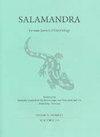白纹盘蝇群一新种(无尾目:盘蝇科)
IF 1.2
4区 生物学
Q2 ZOOLOGY
引用次数: 2
摘要
. 灰浆铁饼属目前包括15个有效种,另有5个候选种已在文献中指出。我们在这里描述了其中一个候选物种,分配给A. albosignatus组,来自巴西米纳斯吉拉斯州espinhaarso山脉的东南斜坡。新种与cavicola隐种,在成虫和幼虫阶段形态相似。然而,这两个物种不是姐妹分类群。这种新种的广告叫声明显不同于其属的所有其他已知物种。对a . cavicola的形态样本的研究证实了该物种在espinhao山脉的存在,但也表明有必要修订里约热内卢州分配给该分类单元的种群的分类地位。眶前线和眶下线分别位于眶内内侧和外侧区域后面。后眶上线和后眶下线在眼后不规则排列。角线从眼睛下方斜向延伸到身体的腹侧轮廓,在身体的中腹侧区域很明显。口前线从口椎间盘外侧延伸并向腹侧接近角线。口腔纵向线位于口腔前线和角线之间。背部和中线从身体背部中部延伸到尾部;第一种,位于中间的,在连接处的前面汇合,并沿着背鳍向后延伸到尾巴的中间;位于背外侧的中线到达体尾交界处,在那里它们加入中尾系列。沿着尾巴近三分之一处,这个中间的系列转向尾部的背鳍,到达背鳍基部,在尾巴远三分之一处变得不显眼。腹侧体线从通气管附近向前延伸至呼吸孔上方区域。在没有神经突的小间隙之后,它们继续从呼吸孔底部下方向腹侧延伸至腹部中部。本文章由计算机程序翻译,如有差异,请以英文原文为准。
A new cryptic species of the Aplastodiscus albosignatus group (Anura: Hylidae)
. The genus Aplastodiscus currently includes 15 valid species, and a further five candidate species have already been pointed out in the literature. We here describe one of these candidate species, assigned to the A. albosignatus group, from the southeastern slopes of the Espinhaço Range, State of Minas Gerais, Brazil. The new species is cryptic with A. cavicola , being morphologically similar in both adult and larval stages. However, the two species are not sister taxa. The advertisement call of the new species is markedly distinct from all other known species of its genus. Examination of topotypic samples of A. cavicola corroborates the presence of this species in the Espinhaço Range, but also indicates the need for a revision of the taxonomic status of populations from the state of Rio de Janeiro assigned to this taxon. praorbital and infraorbital lines behind region medially and laterally to the nares, respectively. Posterior supraorbital and posterior infraorbital lines are irregu-larly arranged behind the eyes. Angular lines extend ob-liquely from below eyes to the ventral contour of body and are distinct in the mid-ventral region of the body. Anterior oral lines extend from the lateral region of oral disc and approach the angular lines ventrally. Longitudinal oral line located between the anterior oral line and angular line. Dorsal and middle lines extend from the mid-dorsal body region to the tail; the first, medially located ones converge anterior to the junction and continue posteriorly along the dorsal fin to halfway down the tail; middle lines located dorsolaterally reach the body–tail junction where they join the middle caudal series. Along the proximal third of tail, this middle series turns towards the dorsal fin of the tail, reaching the dorsal fin base, and turns incon-spicuous in the distal third of the tail. Ventral body lines extend anterodorsally from near the vent tube to the region above the spiracle. Following a small gap without neuro-masts, they continue posteroventrally from below the base of the spiracle to the mid-abdominal region.
求助全文
通过发布文献求助,成功后即可免费获取论文全文。
去求助
来源期刊

Salamandra
Agricultural and Biological Sciences-Ecology, Evolution, Behavior and Systematics
CiteScore
3.10
自引率
15.40%
发文量
0
审稿时长
>12 weeks
期刊介绍:
SALAMANDRA is a broadly based herpetological journal of the Deutsche Gesellschaft für Herpetologie und Terrarienkunde e.V. (DGHT). It publishes results of original research and review articles in all fields of herpetology, including phylogeny, systematics, ethology, ecology, physiology, conservation biology, and captive breeding, given a respective scientific relevance. Shorter contributions on faunistics and natural history, as well as species checklists are only accepted, if findings provide substantive new discernments.
 求助内容:
求助内容: 应助结果提醒方式:
应助结果提醒方式:


